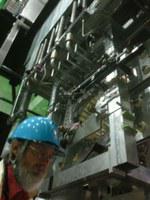The international Tokai to Kamioka (T2K) collaboration designed an experiment to investigate how neutrinos change from one form to another as they travel. TRIUMF researcher Michael Wilking spoke at the prestigious European Physical Society meeting in Stockholm, Sweden, confirming definitive proof of a new type of neutrino oscillation in which muon neutrinos transform to electron neutrinos. It has been known that neutrinos transform from one kind into another, but this particular transformation had never before been conclusively observed and is a major milestone.
In the T2K experiment, a beam of muon neutrinos is produced in the J-PARC accelerator facility in Tokai, Japan. The neutrino beam is monitored by a nearby detector complex ND280 (much of which was built in Canada) and aimed at the gigantic Super-Kamiokande (SK) underground detector in Kamioka, 295 km away. An analysis of data observed at SK associated with the neutrinos from J-PARC reveals that there are more electron neutrinos (28 events) than would be expected (4.6 events) without this new transformation process. This T2K observation is the first of its kind to explicitly see a unique flavor of neutrinos appear at the detection point from a beam initially consisting of a different type of neutrino.
York University made significant contributions to this historic result, focusing on the study of the rate of neutrino production at the J-PARC facility and the rate of neutrino interactions in the T2K nearby detector complex. In order to measure the oscillation effect precisely, these are important components to this measurement since it is necessary to know how many neutrinos are present before oscillations, and how often they interact, in order to determine how many have transformed.
The neutrinos in T2K are produced from a beam of protons. The Optical Transition Radiation (OTR) device monitors the proton beam accurately and is critical for these precision neutrino measurements. York University Physics Professor Sampa Bhadra is the project leader for the OTR, which was built in collaboration with the University of Toronto and TRIUMF. The OTR monitor is essential for the stable and safe operation of the experiment, and the beam properties that it measures are important inputs for estimating the production rate of neutrinos. York PhD graduate Vyacheslav Galymov played a central role in this analysis and with graduate student Elder Pinzon developed analysis techniques to interpret the data from this monitor. Research associate Mark Hartz (also at the University of Toronto) coordinated the neutrino flux estimation needed for the physics measurement. He developed methods to further constrain the models of neutrino production and interactions by using measurements of neutrino interactions in the T2K near detectors. This led to the reduction of uncertainties on the predicted rate of neutrino interactions at SK by more than a factor of two, which along with better statistics, were critical for this significant result.
University of Toronto Professor John Martin was responsible for the construction and installation of the OTR device and recently finished a term on the Executive Committee of the experiment. OTR's mechanical systems were designed by mechanical engineer Mircea Cadabeschi and built mostly at U of T, where graduate student Patrick de Perio worked on understanding the microscopic details of how neutrinos interact with atoms, producing the particles that we eventually observe in the detectors. He also helped develop a new software algorithm with other Canadian researchers for characterizing these particles in the SK detector in Japan. Both these efforts were critical in reducing background from the physics signal and increasing the precision of the measurement used for the new result.
"This form of transformation is sensitive to matter-antimatter asymmetry in the universe," says Bhadra. "What can be more exciting that studying a particle that may hold the clue to our very existence?"
Source: http://www.eurekalert.org/pub_releases/2013-07/uot-trp071913.php
Related Content: Canadians helping to unravel secret of universe's existence

